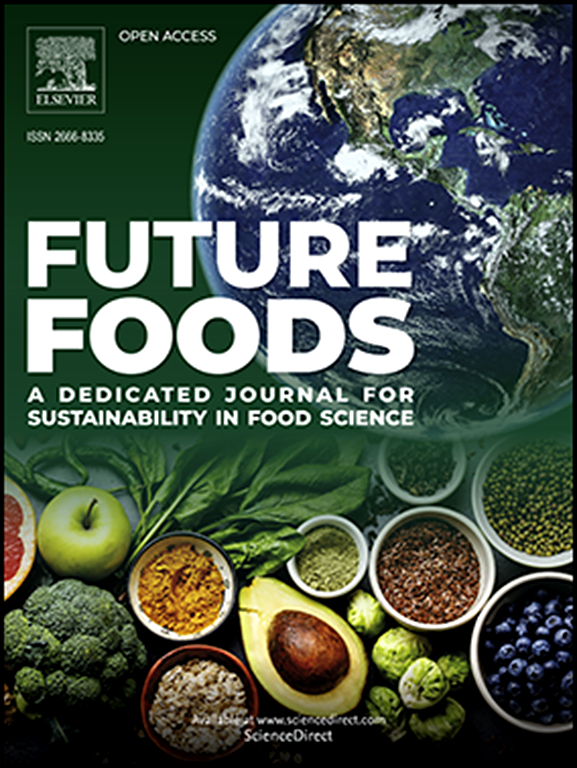Improving the anaerobic respiration of persimmons (Diospyros kaki L.) caused by modified atmosphere packaging through pulsed electric fields: A sustainable technology for extending shelf-life of packaged-fruits
IF 8.2
Q1 FOOD SCIENCE & TECHNOLOGY
引用次数: 0
Abstract
This study investigated the efficacy of pulsed electric field (PEF) treatment in mitigating quality deterioration in sweet persimmons (Diospyros kaki 'Fuyu') induced by modified atmosphere packaging (MAP). The findings demonstrate that treating persimmons with a 50 kV m−1 PEF for 30 min significantly counters the softening and browning effects of 10% CO2 exposure. PEF pretreatment was observed to enhance the enzymatic activities of succinate dehydrogenase by 31.5% and cytochrome C oxidase by 36.8%, thereby boosting energy metabolism and curbing the glycolytic activities of hexokinase and phosphofructokinase by 47.9% and 18.3%, respectively. This inhibition extends to the activity of pyruvate decarboxylase and alcohol dehydrogenase, which were reduced by 27.8% and 23.1%, respectively, leading to decreased production of ethanol (50.7%) and acetaldehyde (28.57%)—compounds typically formed through oxygen metabolism. Furthermore, PEF pretreatment not only preserves the storage quality of persimmons but also activates the fruit's intrinsic repair mechanisms via pressure stimulation. This mechanism enhances the fruit's resistance to quality degradation caused by environmental CO2 accumulation during storage. The findings suggest that PEF is a practical, residue-free, and additive-free pretreatment technology for fruit, aligning well with sustainable development objectives and offering a robust method to protect fruits against MAP-induced deterioration.

脉冲电场改善气调包装对柿子的厌氧呼吸作用:延长包装水果保质期的可持续技术
研究了脉冲电场(PEF)处理对改善气调包装(MAP)诱发的甜柿子品质劣化的影响。研究结果表明,用50 kV m−1 PEF处理柿子30 min,可以显著抵消10% CO2暴露对柿子软化和褐变的影响。PEF预处理可使琥珀酸脱氢酶和细胞色素C氧化酶活性分别提高31.5%和36.8%,从而促进能量代谢,抑制己糖激酶和磷酸果糖激酶的糖酵解活性分别提高47.9%和18.3%。这种抑制作用延伸到丙酮酸脱羧酶和乙醇脱氢酶的活性,分别降低了27.8%和23.1%,导致乙醇(50.7%)和乙醛(28.57%)的产量下降,这两种化合物通常是通过氧代谢形成的。PEF预处理不仅能保持柿子的贮藏品质,还能通过压力刺激激活果实的内在修复机制。这一机制增强了果实对贮藏过程中环境CO2积累引起的品质退化的抵抗力。研究结果表明,PEF是一种实用、无残留、无添加剂的水果预处理技术,符合可持续发展目标,为保护水果免受map诱导的变质提供了一种可靠的方法。
本文章由计算机程序翻译,如有差异,请以英文原文为准。
求助全文
约1分钟内获得全文
求助全文
来源期刊

Future Foods
Agricultural and Biological Sciences-Food Science
CiteScore
8.60
自引率
0.00%
发文量
97
审稿时长
15 weeks
期刊介绍:
Future Foods is a specialized journal that is dedicated to tackling the challenges posed by climate change and the need for sustainability in the realm of food production. The journal recognizes the imperative to transform current food manufacturing and consumption practices to meet the dietary needs of a burgeoning global population while simultaneously curbing environmental degradation.
The mission of Future Foods is to disseminate research that aligns with the goal of fostering the development of innovative technologies and alternative food sources to establish more sustainable food systems. The journal is committed to publishing high-quality, peer-reviewed articles that contribute to the advancement of sustainable food practices.
Abstracting and indexing:
Scopus
Directory of Open Access Journals (DOAJ)
Emerging Sources Citation Index (ESCI)
SCImago Journal Rank (SJR)
SNIP
 求助内容:
求助内容: 应助结果提醒方式:
应助结果提醒方式:


